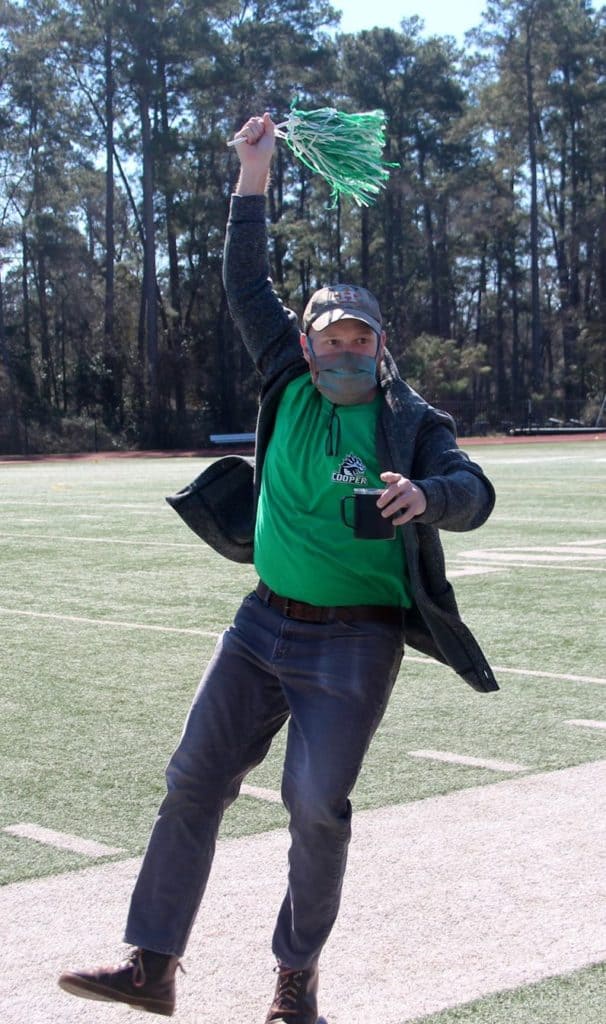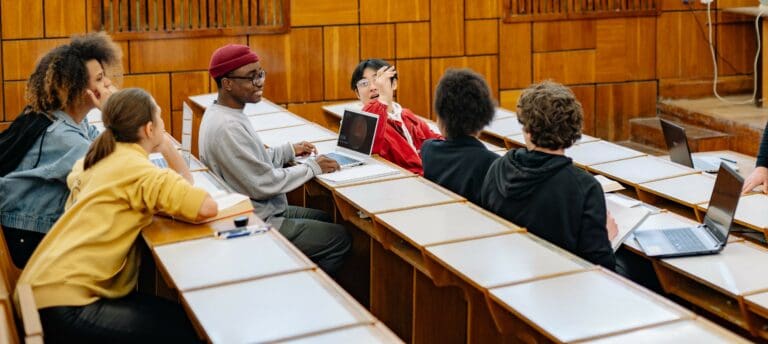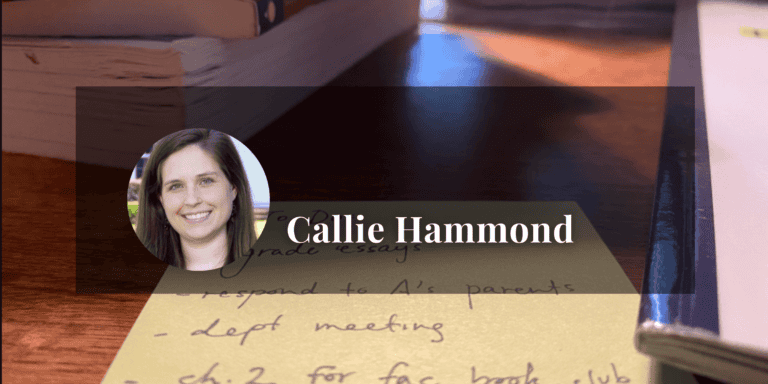Office Hours: Interview with Jared Colley and Stephen Hebert
Office Hours: Jared Colley and Stephen Hebert, Founders and Editors of Rooted
First, how did you come to know one another and develop the vision for Rooted?
Stephen Hebert (SH): I was trying to get out of the New England boarding school world and move back to Texas. I had a friend at the school where Jared was the English department chair. He had an opening in his department, and that friend connected us. Even before I interviewed, we had some phone conversations and developed a real connection.
Jared Colley (JC): We’d connected via our friend and talked a few times to talk about life and our interests, even beyond teaching. We hit it off right away.
SH: We worked together for a whole year!
JC: Then Stephen moved to the Houston area, and the next year I took the job I’m in at an independent school in Atlanta. Our relationship, by that time, was much more than colleagues. Our wives are friends, our kids have playdates; we have a friendship outside of the work we do.
SH: Jared contacted me wondering if I could help him think about redesigning and relaunching his teacher blog when he moved to Atlanta. I said: yeah, we could do that, or, what if you and I sort of blog together. That started the conversation. We’re still trying to figure out what the website is. It’s been more dormant during this year, because it’s been difficult to engage as deeply this year.
JC: I wanted to move beyond just a Blogspot when I reached out to Stephen. I was moving into a leadership role and I wanted to do more with my writing. Stephen is very savvy with web design and I’m not. He kept asking me questions that led me back around to the idea of collaborating. I think both of us have realized as this year piled up that we needed to focus on self-care and stop writing late at night. When I wake up in the morning and go into work, it’s non-stop, then I have a commute, then I have two little girls, and I’m left with nothing at the end of the day. We’re trying to work on getting a rhythm and building up a base of contributors so that it doesn’t feel like constantly churning out content.
How did we get to the name “Rootededu”? I remember we were playing around with a lot of different titles. “The Drunken Pedagogue” was one, but that didn’t feel professional.
SH: We had two things in mind. We felt like there’s the “hyper academic, ivory tower” kind of blog and that’s interesting to read, and then there are folks that write very on the ground, nuts and bolts, practical stuff (the Cult of Pedagogy is a perfect example). We wondered: is there space between to think about the theory and also do some practical stuff? I was a boarding school chaplain for six years. As we approached the uncertain fall this year, I was thinking about how we help teachers to think about their jobs holistically, not just in the clouds or on the ground but also in terms of self-care. How do we think across K-12 schools? Whole-child education also requires whole-self teaching. That got us into tree metaphors — we’re English teachers — and that’s how we got to Rooted.

JC: In Zaretta Hammond’s Culturally Responsive Teaching and the Brain, she uses a tree framework a lot. The deepest level of culture is the roots; the middle is the trunk; the foliage is what you see. We want to think not just about the deep culture of the classroom, but also the fact that every kid brings deep culture into it. How can we get rooted in this year that feels so out of control, when we feel so unsafe? What are our values? We list our values very clearly on our website and want to think about how to approach education with all of that in mind.
French literary theory is a huge influence for me, Deleuze and Ranciere specifically. Ranciere wrote The Ignorant Schoolmaster — you read it too, Stephen! — and he talks about how we have to start at the radical axiomatic idea that all students are all equally intelligent and equally able to learn anything. He means it! People draw back when I say this. But if we start with this idea, how radically would that change education? What might it make possible?
My main focus at work right now is training and coaching teachers who have for the first time shifted to a competency-based curriculum. They’re no longer grading in the same way. There are learning outcomes and competencies. You’re not grading an essay, you’re grading discreet standards, and you have to do it on a proficiency scale. I like it because we’re breaking it down and showing a kid “you can do this.” It dovetails nicely with Ranciere’s framework. Some teachers really struggle with it! A teacher I’ve been working with showed me how the standards earned the student an A (we still have to translate scores for transcripts), but the teacher resisted claiming “I don’t know. He’s a B student if you ask me.” We struggle with the biases and the gut instincts, but grading standards and competencies as opposed to essays and quizzes helps mitigate some of these tendencies. It’s so important to get there. Ranciere’s radical starting point also helps us overcome biases through which we see some of our students. Some teachers would go crazy if you brought Ranciere into it, but we don’t need that. But that’s the root.
On your website, you describe yourselves as “pedagogical ecologists.” The description certainly fits the “roots” metaphor. What does this term mean to you, and how does it differ from other ways of thinking about teaching?

JC: In Alison Gopnik’s The Gardener and the Carpenter, she shares two models of raising kids, which we can also translate into models for teaching. In the first, you look at teaching from the carpenter point of view. You’re making models, making kids into a likeness of something. A lot of our schools participate in this. You have to have a completely controlled environment to make things happen according to specifications, if this is your model. The second model is to teach like a gardener: planting seeds and trying to feed plants as they grow. You can’t control all of the conditions, but you can tend to the garden and take care of it. That’s a planting seeds model: the idea is that “you still need me to help shape you in some regard. There’s still something missing – perhaps a seed that needs planting.” What I like about our ecologist model is that you’re trying to preserve what’s already naturally there, to protect it. You try to emancipate kids to realize that they can take control of their learning. I don’t need to plant or kill seeds. There’s a best version of every kid already there. If we have the right kind of design in education, they’ll take control of it and really learn about it and from it. Dewey often talked about planting seeds. Let’s go a little further there.
SH: I would argue that the seeds are already planted, already, before the students come to us. I came to this understanding from a parental lens. Together, a few years ago, we read John Warner’s Why They Can’t Write, and as I was reading I saw a culture of compliance and surveillance about kids. I was watching my (at the time) second grader go through that experience in school; he’s a free spirit, a bit of a wildcard. We were watching him get cut down by this system that was saying “you have to do this and this and this.” I watched his personality change as a result of this training. For me, I was like: there’s so much here, and if we just understood how to direct it, that would lead to a better outcome in terms of developing his interests and personality. Nobody’s coming into a classroom as an empty vessel, without preconceptions and skills and culture. The question isn’t about changing those things, but about pulling the levers.
JC: One more thing that’s really important to me, as an ecologist, is that we want to activate students to, when they see a problem, go do something about it. A lot of times, we create a culture in which maybe we can get kids to think critically, but they’re still in the armchair. I want students to feel okay getting out of their desks and following their inspiration to go solve a problem. If I were Stephen, with his son, I’d be worried about creating compliant kids who lose the desire to act.
Given the pandemic, and the overarching recognition of racial violence and bias in America, what have been the biggest challenges, in your minds, to fostering healthy and robust growth like this in classrooms over the past year? Are they new, or are they just versions of something we’ve seen before?
SH: For many teachers who were able to rely on a certain set of tricks and skills, those are gone after moving to a virtual or hybrid teaching model. You can’t, over Zoom, do things the same way. You can’t build off of teacher-centered models there. I’m still struggling to build community in my own classes. My students have always appreciated a community focus in my classroom, and that requires environment and attitude and engagement that don’t operate in the same way right now. Even the physical barrier of a mask – Jared wrote about this on Rooted – changes that relationship between teacher and student. Some of the things that we were really comfortable with as teachers have been taken away, exposing the cracks that probably were already there. Students are addicted to their phones, yes, but if it wasn’t that, there was something else before that that was vying for the attention of students. Yes, screens present a problem, but you can manage that problem. I worked with an administrator once who would complain and make rules about using technology during meetings. I thought: maybe your meetings should be more engaging. He didn’t like that response, but I stand by it. If I don’t have all the students in the class engaged, that’s a reflection, in part, on me and my efforts. What could I be doing to ensure that this particular activity is equitable, accessible, challenging for everyone? Some kids have different needs. Though a lot of these questions about access and technology have been exposed more lately, they’ve always been there.
JC: I wrote another article about Ivan Illich, who wrote Deschooling Society, and he talks a lot about manipulative versus convivial institutions. A manipulative institution is something like a prison, where you manipulate people by mechanisms of power and control. A convivial institution is something like a community center or a park. We’re not trying to manipulate how you use it. The convivial institution is just there for people to freely use as it fits their needs and interests. Sure, there are still cooperative norms that would still be followed there. They’re not compliance-driven rules though. Thinking about that, I wrote about how the problems raised by teaching during the pandemic aren’t new. They expose something schools have always been doing — relying on manipulative logic of bells, asking for permission to leave, seat time — that’s super manipulative. We’ve relied on extrinsic motivators on an institutional level.
What teaching over the past year exposed was that even teachers who thought they were really doing great in the old framework were still benefiting from the manipulative imperatives of that environment, these extrinsic factors that made their teaching work. We don’t have control over those in the same way in this environment. Kids can just drop off the Zoom call. Parents might not be able to be as involved. Even the best of us had these invisible factors that made school “work” that aren’t necessarily good or important. A lot of teachers are frustrated that the tricks don’t work anymore. But that’s not necessarily a bad thing; it could be good for us moving forward as we think about better ways to engage and motivate learners.
At REAL, we have a mission to create equitable structures that can allow conversation to flourish beyond the room, physical setup, or strategies that have defined “classroom conversation” for a long time. One of the models that educators often bring up, which applies here, is a vision of a playground in a park: it has a few places to go that are set up to provide different challenges, viewpoints, and layouts. We build that playground and then see what happens as students explore it.
SH: This makes me think about my World Religions elective. It’s a semester-long course in part inspired by Jared and a guy named Nick Dressler. Both of them had gotten into gamification, which I struggle with for a variety of reasons. Part of what I kind of stole from them was creating a radical model of student choice. To go to that park metaphor, in this moment of the course where we study Buddhism, there are fifteen different things that I offer to students to explore. There are two that are required, that everyone needs to know, and then everything else is something that you can pick. Ethics? Awesome. History? Great. You can do different artsy, writing, video projects with the material. And then, my class time is largely like, okay, you’ve got the next sixty minutes to work on… “Buddhism stuff.” There’s part of me that, as a teacher, because I was trained in a maintain-control model, makes me want to check in all the time. But it’s okay if they’re also having a conversation about what lunch is later today at some point during the class. Letting go is hard. I’ll be honest, I’ve tried every class discussion model under the sun, and on Wednesday, once a week, we have a shared discussion experience in which students teach one another what they’ve learned. Those conversations are awesome, because students don’t feel like there’s a grade associated with it — it’s just us coming together, and it feels novel because they’ve spent most of the time exploring and now they each get to bring something to the table. By letting go and pointing out the features in that playground, I can give them places to go and let them define the experience from there. It creates a laid-back atmosphere, and the students in the group feel no pressure, which is like a respite from the rest of school. When I sit down with the kids, I find that they’re also learning.
JC: I think that something we often miss in discussions is that they can be very function-focused designs, not human-focused designs. It makes sense, from a logistical view, to do it that way. But if we’re not caring for the student and therefore preparing them, in an equitable and equally accessible way, there was no human-centered design there. At my school, we talk about design thinking in everything we do. You always think of your primary user: the student. How might we design this from a truly empathetic point of view? We’re also talking about preparing, scaffolding, and caring for students before just throwing them into some Harkness-pit.
One of the things I like to do that’s been super successful for me is the live interactive Google Doc. Well before we have the discussion, I, with the kids, have posted questions that we could maybe-talk-about. What I ask each student to do, privately or publicly, is to initial the questions or concepts (with a plus sign) signifying that they have something to say about it. Then, kids can prepare, but I can also create space for students who feel they don’t have as much to say. I also ask them to initial (with a minus sign) questions that you feel like you would have nothing for. Maybe you’re not comfortable talking about it, maybe you’re not interested in it. You’d rather not talk about it. When I started doing that, there was an interesting, happy accident. It felt pretty low-stakes. But also, when I’d go look at the document before school, I’d see questions with a ton of plus signs, questions with a mixture of pluses and minuses, and tons that also had mostly minus signs. It gave me a lot of information about when to get out of the way, when I’d need to make pairs to pair and share, and maybe where I might need to direct-instruct. A simple gesture really created more equity in my classroom.
SH: What we’re really talking about is the lack of equity in class discussions. We all know that the squeaky wheel is when one person dominates the classroom and it’s not fair. There are a couple of other things going on. What is it that this group wants to talk about? There’s also a need for understanding of the minds and hearts that are in the room. A few years ago, I had an experience with this student where he’d turn in a piece of writing with incredible depth, but then he’d give me nothing in class discussion. His advisor and other teachers had the opposite experience — he was always on fire in class. Finally, halfway through the semester, I met with him and asked him about it. Unbeknownst to me, his mortal enemy was in the classroom, and he didn’t want to engage with that student who was going to make fun of him for what he said. There was nothing that I could do about that. What am I going to do, attempt a schedule change? That kid didn’t feel safe in that space, but his grade was going to be impacted by the fact that he can’t get past that. We, as teachers, don’t have control over that, and we don’t always know that that’s what’s going on.
There’s no way that we can guarantee that a discussion is equitable. What we can work toward is finding as many ways to get student voices into it as possible. If you have a small enough group, you can really get to know them well enough to know what’ll excite them. In Jared’s case, here’s a way to quantify what’s going to be fruitful and exciting for students. To me, pedagogy requires us to be attentive to the moment, and not just be people fulfilling a recipe. If you’re looking at a classroom as that, then you’re kind of denying the reality of this moment. This is the only moment you’re in the classroom with this student, and it’s never going to happen again (that’s the Buddhist in me). There’s a magic to that, but you have to be able to see it and not be afraid of it. To go back to the question, I think that a lot of us, like I was, were trained as teachers in a system where our job was to walk through someone else’s lesson plan step by step. That does not work in 2021.
Some of the content on your website is specifically geared toward teacher care. Why is that an important element of your work? What have been some recent insights and revelations there?
SH: It’s interesting because my thinking on this has evolved quite a bit this year. At the core, there’s a reality that exists that teachers exist in an industry that expects us to sacrifice of ourselves for less money than other professions. I know a lot of teachers that don’t feel cared for. Teachers need to feel cared for. If you’d talked to me at the beginning of this school year, I would’ve said: teachers need to practice self-care because no one’s going to care for them. I still think that, and I worry that I’m part of this “industry,” but I think I also worry that self-care has become just another thing on the teacher checklist. That’s not the way that it should be. I don’t mean to express ingratitude, but I recently had this experience where the school was attempting to express appreciation, but it actually just highlighted all of the burdens and expectations of my job. I’m expected to give everything away and not expect any real financial reward. Self-care is definitely necessary, but there’s a give and take: now it’s become like, now I’ve got to fit in my meditation because if I don’t, I’m not a good teacher. So many of us teachers have this guilt suck. I’ve spent the whole year thinking about how I’m doing a crappy job. Now, if I add on this other task, that’s not going to help. That’s where my thinking is right now. How do we get to a point where the idea of teacher fulfillment and self-actualization is just baked into the system, isn’t something that I also have to take care of in my spare time? In the moment, the number one thing we need to do is: cut yourself some slack. Part of what we’re getting at with the idea of the ecology of education is that learning is happening, even if you’re overwhelmed with what’s not going well, or if you’re not sure learning is happening. It may not be that learning that you anticipated, but that’s okay.
JC: We need to name things. We need to name our fears, what’s stressing us out, and we need to feel safe in doing so. It’s good for people like me in leadership to invite that in and to name it as well. Yes, I’m leading grading policy, but I can’t just go there without naming what we feel about the work that we’re doing. I would prefer not to have to lead a Zoom workshop — like Bartleby, “I would prefer not to.” I’m scared of Covid, but I don’t want to lose my job. We have to name things. Leaders have to name things, to make space to talk about things other than professional learning.
Another thing I’ve been doing with the faculty at my school is this: every Monday I write a weekly update email. Usually, it would have a lot of housekeeping. Now, 80% of that email is spotlights and celebrations. It can be seen as superficial, but if it’s sincere, and it’s specific and named and thoughtful, it can be meaningful. If it can be part of the rhythm of the week, it’s helpful. One more thing I would name, coming at it from a leadership position, is that faculty need to have a voice, to be able to give feedback, to be a part of conversation. It’s important to add that one must sincerely be ready to act on that feedback when you get it. Even if I don’t have control over all things at hand, it can help me to be receptive and expand the conversation. It’s helped to remove some of the manipulative elements for teachers — encouraging teachers to take their paid days off, to leave the school building if they don’t teach after 1:00 and don’t need to be there. Every leader needs to take a paid day off, too, to show it’s going to be okay if you do.
It can be difficult to make change at schools, to suggest a different way of doing things, from a teacher’s position. In many independent schools, student activism (through “Black At” social media pages, for example) has inspired more teachers to make changes in schools, but we can increasingly see that truly building systems of care in schools means much more, and much differently, than we previously thought it did.
JC: It shouldn’t have taken the Black At pages to create change in schools. For too long we have not been seeing the trauma that exists in predominantly White institutions. We need to lean in to having uncomfortable conversations around diversity, equity, and inclusion. At my school, we hired an outside consultant to work with us, because we needed an outside voice. We’ve had some truly candid conversations, including fishbowl conversations, that create space for anyone who wants to talk: what hasn’t been seen? Because it’s been sincere, and because there’s been an outside consultant coming in with sincerity, it’s been helpful to allow people the time to have these conversations instead of doing stuff on in-service days about housekeeping and pedagogy. At first, there was a lot of fear from colleagues and community members of color, but because the conversations have been as well-facilitated as they are, it’s been impactful.
SH: To bring this sort of full circle, one of my roles at The John Cooper School is that I’m one of the Upper School diversity coordinators. We’re not where Jared’s school is yet, but we are working toward that. This issue of self-care — a lot of it gets taken care of if you create the community and the culture of community in the school that allows for diversity. One of those types of diversity is the diversity of approach and differences in pedagogical approach. I try to be out there on the fringe, and there are plenty of times when I’ve realized that I need to be reined in. But there are plenty of times where I’ve also pushed colleagues. Part of building culture and community is figuring out how we, as a group of 22-60-something year olds engaged in the mission of educating young people, take care of one another. I’m deeply thankful for, working with Jared, there was a crew that took care of each other. I’ve found that everywhere, there’s a community of people to take care, if you’re willing to open up and be part of that community. And a lot of people aren’t. They want to just do the job and come home. We need those people too. They can help you to gain perspective.
And often schools need to provide and cultivate communities for faculty of color, LGBT+ faculty, and other members of marginalized communities that might be different from or operate in different ways from that overall community of care.
SH: One of the positives coming out of 2021 is recognition that we might need affinity groups for faculty, too. At my school, I’m not part of that conversation, I just get to put it on the schedule. Creating those opportunities is so important. Who is going to avail themselves is who will. We have to create spaces and opportunities for connection for those who need it with others who share their experiences. We have a schoolwide focus on mindfulness; it’s part of our ethos. It’s good for us. We also create those spaces for students and staff to learn and practice. Does everybody love it? No. What a waste of five minutes. For me it’s the best five in the day.
What is one prediction that you have for the future of education?
JC: I struggle with this question. We always talk about the future of schools instead of the present. I would hope that, going back to what I was alluding to earlier about manipulative conditions, that this has been a bit of an exposure moment where people are realizing they need to adapt to a different vision of how they are as a teacher and what they do to engage students. I wonder and worry whether independent schools markets will allow the virtual thing to go away once COVID is behind us. A lot of parents now want to visit colleges and have their kids on Zoom while on the road, so to speak. Will that go away? Will it go easily? I worry about that. I hope that we can all agree that concurrent hybrid learning is the least effective environment for effective pedagogy and deep engagement. Another worry I have is that — the opposite of my hope — and I empathize with it — have we backtracked a little bit on our pedagogical willingness to risk and explore, and tweak. A lot of us are like, look, I’m going to do it this way because it’s what I can do right now. I hope that we get to a place soon where Covid’s gone and teachers can go back to being classroom (or online!) teachers, one or the other, in a modality where they can really thrive as pedagogical innovators, not pedagogical survivors, as we are with the hybrid classroom.
SH: If you’d asked me this in May of last year, I would’ve said look at the outpouring of support for teachers, the way that people are finally viewing this profession as difficult and worthy of respect, is going to transform the field. But that’s not really happening anymore. The pendulum has swung. Last year I was seeing the future of K-12 education as potentially moving into this golden era where we learn a lot of lessons from this hybrid/virtual moment and will reap the benefits of a public that’s engaged in the importance of education beyond just the standardized tests. I don’t think that anymore. We have this monthly optional meeting about assessment, just to talk about it, and it’s kind of the teachers you’d expect to show up: the ones doing weird, crazy stuff. The topic this past month was: what in your teaching practice will you keep/get rid of once the pandemic is over. I don’t remember anyone saying they would keep anything from this year. Last year we all were more optimistic. I think the future of education I see is, when I think about the positives, there is an opportunity to continue to move forward with the idea that teacher control was always an illusion. The things that we have relied on, the tricks up our sleeves, to maintain this illusion, I don’t think are going to come back. That’s a great thing. Because what we’ll see on the other end is a classroom like a garden. Flowers over here, a hedge over here, I’m preparing this soil over here. We think of these things as kind of Montessori in their approach, but there’s a freedom to explore that as a teacher I haven’t yet envisioned, because I don’t have all the answers. Maybe my greatest hope is that this pandemic opens up the space and allows for exploration. That’s the dream.






